

Sew-along with us!
Perhaps you'd like some company while you sew? We've sewn up each of our patterns and photographed each step along the way. Find the pattern you're after in the filter drop down below left.
Sew-Alongs
Strathcona Tee Sew-Along: How to Sew with Knits
Welcome to Sewing with Knits 101! I've written a Question and Answer post featuring the main questions that weighed heavy on my mind when I first began to sew with knits. Judging by the emails we get about sewing with knits, these questions are also worrisome to many of you! I hope this post will answer them so that you feel confident to get sewing:
Will my machine sew knits?
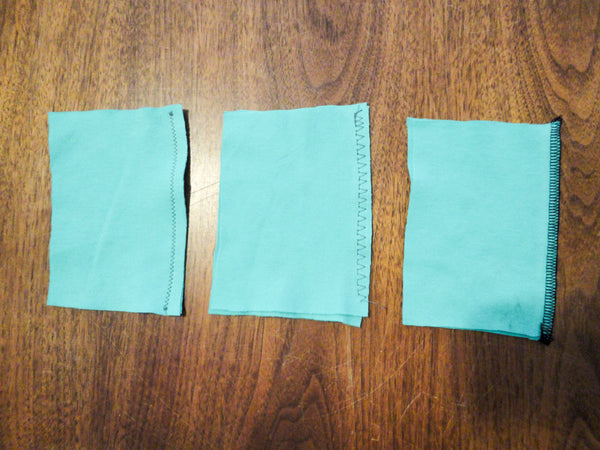
- Three machines, three stitch types: A basic machine with a zig zag stitch, a fancier machine with a "stretch stitch" and a four thread serger.
If you have a basic sewing machine featuring several stitch styles:

A small zig zag stitch sewn with a regular ol' domestic machine.
Yes! Your machine probably includes a stretch stitch style and will most certainly include a zig-zag stitch. Your goal when choosing a stitch is to find something that will allow the stitches to stretch so that they don't snap when the fabric is stretched (i.e. when the t-shirt is being pulled on over the wearer's head). Test all of the stretch stitch styles to see which one you prefer. I have had sewing machines in the past whose stretch stitch did not allow the fabric to stretch enough for my liking and I found the zig zag stitch was the best choice. The sewing machine I have now has a killer stretch stitch that I almost prefer to my serger because it works like a charm no matter what fabric I am sewing! Once you've found a stitch that stretches to your liking, sew a practice seam and spread it open - do you see thread ladders, bubbles or a tidy seam? If you are using a zig zag stitch the best way to produce a tidy, straight seam is to use a narrow stitch width.
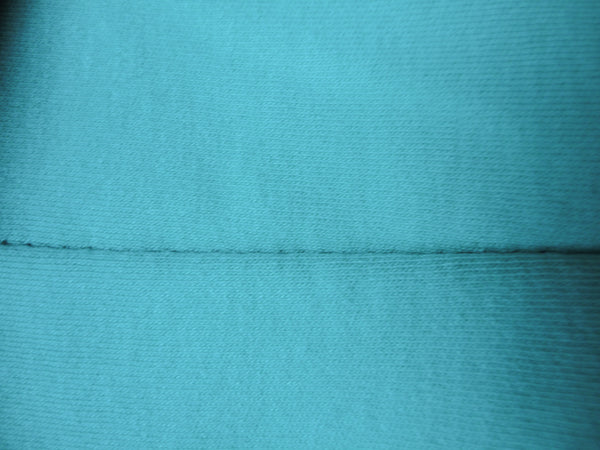
-
A fairly nice seam with a few small thread ladders visible (these would be less visible if I used a teal colored thread!).
If you have a fancy sewing machine with many stitch styles:

A neat "stretch stitch" option on my fancy old metal Kenmore. There are all sorts of stretch stitch styles so yours might not look exactly like this.
Yes! You are spoiled for choices :). Try out all of your stitch styles to see which one performs best with the fabric you are working with. Thicker knits might sew up nicely with a fancy stitch style that includes many needle holes but you will probably want to avoid this stitch style if you are working with thin and stretchy jerseys. The more the needle punches through the fabric, the more it weakens the fabric - not something you want when your fabric is quite delicate to start with! Of course, you can combat this by using a ball point needle - these round tip needles push past the fabric fibers rather than piercing and breaking them. There is a good chance that your fancy sewing machine came with a walking foot. Now is the time to pull it out! This foot will help to ease the top layer of knit fabric through at the same pace that the feed dogs are pushing the bottom layer through. You will be able to stitch even the most slippery and ungainly knits without distorted seams and rippling hems!

Less visible thread ladders on this seam! I might want to decrease the stitch length though so the gaps appear smaller.
If you have an older sewing machine or industrial sewing machine with only a straight stitch:
While most people would probably say no, I say yes! Just because you only have a straight stitch at your disposal doesn't mean you should avoid knits altogether. The garments you sew with a straight stitch will be more prone to developing holes in the seams if a stitch snaps but you have a sewing machine right there ready to run over any seams again if need be! Besides, if you are gentle when putting on the t-shirt, you can likely avoid breaking any threads. Increase your straight stitch length slightly to allow for a bit more stretch. To finish your seams you could sew another row of straight stitching or choose a knit fabric that isn't prone to unraveling (a jersey for instance) and skip seam finishing altogether!
If you have a serger:

Of course! Sergers are designed to work with knits. Depending on your machine, you can set your threads up to stitch the seam and simultaneously finish the seam allowances or you might stitch the seam using a zig zag stitch and then finish the seam allowance with the serger. One thing to watch out for when serging knits is for stretching or puckering of the entire seam. Below you can see a stretched seam on the left, a puckered seam on the right and a nice straight seam in the middle. To avoid puckering or stretching, play with your differential feed knob and a few fabric scraps each time you start working with a new knit fabric.
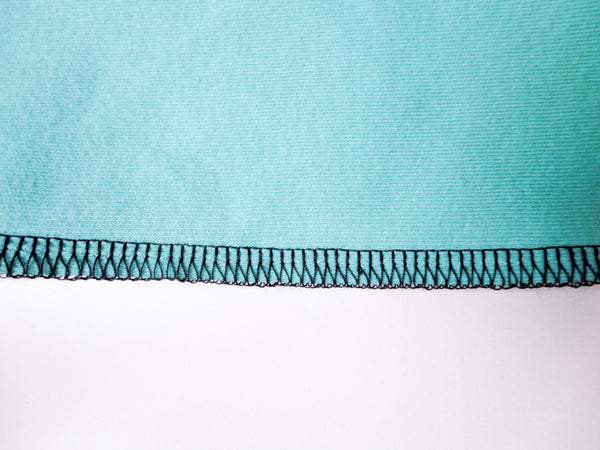

The serged seam - my favorite of all the seams!
My knit fabric won't cooperate while I cut out my pattern - do you have any tricks?
Trick #1: Cut on the floor
You won't have to worry about your knit slipping off the table as you cut if you spread your fabric out on the (clean) floor. If you have a large table that allows you to cut with your entire fabric spread out flat, this will work even better!

Trick #2: Cut out a single layer of fabric

If your knit fabric was knitted in the round (as is commonly the case), you will need to cut the tube along the grainline so that you can spread out your fabric as one layer.
While most sewing patterns ask you to cut out your pattern pieces with your fabric folded in half (with the selvedges together) it is more accurate to cut out knit garments using a single layer of fabric. Working with a single layer will allow you to ensure the knit is completely flat (without folds and ripples) and isn't stretched/distorted in any way. If you have a pattern piece that is supposed to be cut "On the Fold", trace the other half of the pattern piece so that you have paper pattern pieces representing the entire front and back of the garment and do not need cut along the folded fabric edge.
Remember, if you need two of one pattern piece it will need to be mirrored! For example, if you are cutting out sleeves, cut out the first sleeve with the pattern piece right side up on the fabric. Cut out the second sleeve with the pattern piece right side down on the fabric. This will result in two mirrored sleeves (a right and a left sleeve).
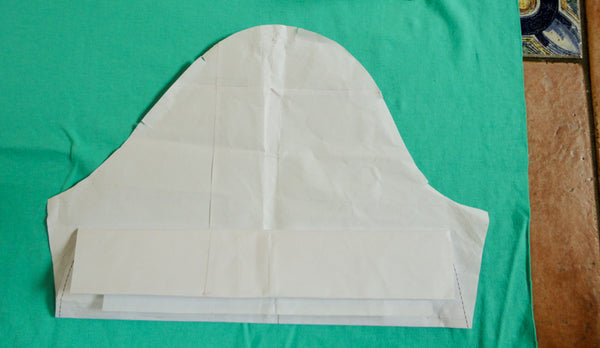
Don't forget to cut mirrored pattern pieces!!!
Trick #3: Use weights
Place heavy items (rocks, soup cans, pattern weights) on your pattern piece and on the fabric around the pattern piece. Weighing everything down will help to combat the shifting of your scissors so that the fabric stays in one place and un-stretched as your scissors move along the edge of the pattern piece.

Trick #4: Use a rotary blade or slide your scissors
It is important to cut extra carefully when working with knits because the scissor's movement can easily pull the knit fabric out of place resulting in jagged edges or misshapen pieces. A rotary cutter eliminates any issues caused by scissor blade movement. If you are using scissors to cut, slide the bottom blade of your scissors along the floor or cutting surface and move the top blade up and down. This can be tricky to get the hang of but it will result in much more accurate cutting!
I want my t-shirt to be the best that it possibly can be! Do you have any tips for cutting out the pattern pieces?
Tip #1: Keep the direction of greatest stretch in mind when placing pattern pieces
Double check (or triple check!) that you are laying out your pattern pieces so that the direction of greatest stretch runs around the body (rather than up and down the body). If you cut your pattern pieces so that the stretchiest direction of the fabric is vertical along the body your knit garment will stretch and sag out of shape. When cutting out the neck band for a t-shirt, you have a couple of options for placing your pattern piece on the fabric. If your knit fabric is especially stable and you are worried that your neck band won't be stretchy enough, place your neck band fabric on the bias (at a 45 degree angle to the grainline). If your knit fabric is sufficiently stretchy, place your neck band so that the longest edge is aligned with the direction of greatest stretch (and the narrow edge is aligned with the grainline). This will allow the neck band to stretch around the neck to help to retain the shirt's shape.

Even though your pattern piece might indicate cutting the binding on the bias, use your judgement based on what type of fabric you have chosen. This neck binding is being cut out with a stretch ribbing so there is plenty of stretch available when I place the long edge of the binding in line with the direction of greatest stretch. If you were using a very stable knit, you might consider cutting the piece on the bias to create more stretch!
Tip #2: Ensure your pattern pieces are completely on grain
Cheap store bought t-shirts often have a very obvious problem - they twist around the body as you wear them so that the side seams are angling towards the front and back. This twisting problem occurs because the grainline is not running vertically down the shirt front and back, instead, it is on an angle. When the manufacturers cut out the fabric they stacked many, many layers of knit and then sawed through them to cut out the pattern pieces. Either the blade of the saw was not sharp enough or the layers of fabric were too thick for the saw to handle, as a result some of the fabric layers (likely the loose ones on the top and bottom of the stack) shifted as the saw cut resulting in twisted, off grain pieces. Don't replicate this common problem while sewing your custom t-shirt! Place your paper pattern piece on the fabric and measure from either tip of the grainline to the fabric selvedge to make sure that the grainline is aligned to the selvedge evenly (pictured below).


Tip #3: Cut notches outwards
Knits can be prone to 'runs' just as you might see on a knit stocking. Cutting notches inwards as you might normally do when cutting out a pattern weakens the seam allowances of the garment. As you wear and wash the t-shirt you might be horrified to notice that your t-shirt is unraveling at the seams where you cut your notch! Instead of cutting notches inwards, cut little triangles of fabric outwards. If you prefer not to perform this fiddly cutting technique, you could just mark your notches with chalk or a pencil - easy peasy!

Best wishes while you cut out your Strath Tee! If you take the time now to ensure your machine is operating at full capacity and that your fabric is accurately cut out, the actual sewing of the t-shirt will be a total breeze. Use the #StrathTee to show us the fabric you've chosen and to give us a look at your seam sample progress!
Strathcona Tee Sew-Along: How to Choose Men's T-shirt Fabric

Choosing the perfect fabric is the most difficult aspect of sewing a men's t-shirt! This guide will help to demystify menswear appropriate knits so that you can start the sewing confident that you will end up with a classic and flattering T-shirt.
What makes a t-shirt knit masculine?
To many people, the answer to the above question would be easy - they would say that the knit must be 100% cotton and of medium weight. As you may have already discovered, it can be very difficult to find such a fabric at your local fabric store! I am here to argue that you can make a very manly t-shirt with all manner of knits. Let me prove this to you by showing you some big brand store-bought examples ranging from basic cotton interlock to blended fabrics completely void of cotton!

- 99% Cotton, 1% Polyester Jersey T-Shirt from H&M - polyester blends are very commonly found in graphic tees or event tees. A blended fabric can include a far higher percentage of poly than this example but it is important to keep in mind that this will result in a 'sportier' shirt, sweat wicking shirt best suited for the gym. A small polyester content will often result in a t-shirt that doesn't wrinkle when it comes out of the dryer or out of the dresser drawer!

- 95% Cotton, 5% Spandex (i.e. Elastane) Jersey T-Shirt from H&M - a fabric with spandex content is best suited for tight fitting shirts that feature areas of negative ease (notice how the shoulders, chest and sleeves in the above example are skin tight). Spandex content will often result in a heavier and more drapey fabric so it will cling to the body in an unflattering way if it is used with a loose fitting t-shirt design.

- 85% Viscose (i.e. Rayon), 15% Wool Jersey T-Shirt from H&M - this example illustrates how fun it can be to experiment with fiber content when sewing t-shirts! If you are into hiking and camping you might be interested to make a t-shirt 'base layer' out of Merino wool. It isn't difficult to find Merino wool yardage and the resulting t-shirt will cost FAR less than fancy base layer garments from outdoor stores!

- 100% Slub Cotton Jersey T-shirt from J.Crew - It can be fund to experiment with textures when choosing t-shirt knits. A slubbed knit can look very rugged and masculine. I find that if a fabric is slubbed and heathered and fairly light weight, it will result in a t-shirt that looks attractively reminiscent of a cowboy's undershirt ;).
As you can see, most of these shirts feature medium weight fabrics with little drape and minimal stretch. It is interesting to note that the only shirt containing spandex content features a much tighter fit than the other shirts. Since spandex content is becoming an increasingly common element in knit fabrics, it is good to know that a masculine t-shirt can still be produced with the spandex-laden fabrics found all throughout fabric stores.
Aside from fabric content, it is important to note the style of knit. An interlock knit is stiffer and has less drape than a jersey knit. I find that if I am in doubt about the suitability of a fabric for menswear (especially if I am choosing a printed fabric), I will err on the side of caution by using an interlock rather than a jersey.
Check your closet!
So now that we've determined that there is a surprisingly large range of acceptable fabric types, we must narrow things down by keeping the prospective wearer's preferences in mind! The easiest way to do this is to open up the recipient's closet and look at the t-shirts that are already there. Are they mostly of medium weight? What do the fabric content labels say? Do many feature unusual textures and graphics? Are there a broad selection of styles or does the person favor one type of fit?
Here are Matt's favorite t-shirts as an example along with why they are his favorite:

He has had this free event t-shirt for MANY years and it is only just now beginning to show wear. He loves that the hems do not fold up and wrinkle as many of his t-shirts with less polyester content tend to do. The weight is quite heavy compared to some of his more 'fashionable' t-shirts but the polyester adds a bit of fluidity to the fabric so it doesn't look too crisp and so that it forms to his body just enough to be flattering.

He wears these v-neck H&M t-shirts often because he likes the fit of the sleeves and the v-neck (and the selection of bright colors). He wishes that the fabric were slightly heavier because they tend to show a bit of nipple!

While he wears these Armani t-shirts often, their tendency to wrinkle bothers Matt. The sleeves are always folding up and the narrow neck binding makes them look a bit misshapen. These shirts were designed as undershirts rather than t-shirts and the fabric is even more light weight than the H&M t-shirts due to this. Matt requires all of his clothes to be suitable for mulitple purposes so a thin t-shirt meant ONLY for use under button-ups does not suit his wardrobe.

This is Matt's favorite Strath Tee! It is made using a Girl Charlee knit that is no longer available. I think it may be a blended cotton/poly knit. It doesn't contain very much stretch and it is of light to medium weight (a touch heavier than the H&M tees). Matt gets compliments on the print CONSTANTLY and he feels really confident in this shirt. I shortened the sleeve length considerably to be the most flattering length for Matt (I will talk about this more in the next sew-along post!). I think that the print suits the crew neck style and might be a touch more wild than Matt prefers if it were on a v-neck shirt.
How thick? How stretchy?
I like to err on the side of thick and not very stretchy but picking fabrics with different properties (thick and quite stretchy, thin and not very stretchy) is still a possibility as we saw in the ready to wear shirts above! Here are the fabrics that I picked for the Strath Tee sew-along. They include:
A 100% Cotton Interlock of medium weight with matching 1X1 ribbing...

A 100% Cotton Interlock of medium weight without ribbing...

A 100% Cotton Jersey of light weight (note that there is no spandex content so this fabric does not contain too much drape)...

A cotton/bamboo blend jersey of light to medium weight (sorry, I don't know the percentages!)...

You can sort of see their relative thicknesses here (the teal and white knits are the same fabric in different colours so I only photographed the white interlock):

And here are their stretch capabilities:

I have stretched each fabric as far as it will stretch without becoming misshapen. None of them are able to stretch very far but I was surprised that the cotton/bamboo jersey stretched farther than the interlock! The cotton jersey stretched least of all and bounced back to its original shape the slowest of the three fabrics.
Do I need ribbing?
As you may be able to tell in the photos of store bought t-shirts at the top of this post, most modern t-shirts do not feature heavy ribbing at the neck band. 1X1 ribbing is the most common choice for modern t-shirt neck bands. 2X1 ribbing used to be a fairly common choice for men's t-shirts in the past (these "Ringer Tees" would often feature ribbing at the sleeve hem as well) but this is no longer the case. In fact, I have recently been noticing store bought men's t-shirts with self neck binding rather than ribbing!
The advantage of using ribbing to bind a t-shirt neckline is that your neckline will not be prone to stretching out. Ribbed knits spring back into their original shape very quickly. If you can't find matching or contrast ribbing, test your fabric's shape retention abilities by stretching it considerably and then releasing it. Does it revert to it's original shape or does it look a bit saggy and stretched out? If your fabric contains a small percentage of spandex, you will easily be able to skip purchasing ribbing because the spandex performs the same job as the rib knit. If you are using a 100% Cotton knit that is quite crisp, you may find it keeps it's shape tolerably well. If you are using a blended jersey with considerable drape, you will likely find that the fabric is prone to dragging and drooping once it is stretched - you can combat this by cutting your neck band shorter or by finding a ribbing fabric for your neck band.
Can I use prints?
When deciding on a fabric choice, you might be tempted to use crazy prints. While many menswear enthusiasts will urge you away from all-over prints...I say go for it! Here are my reasons why:
- It is next to impossible to find a border style print that you can position just over the chest of the shirt to simulate the appearance of your average graphic tee - believe me, I've tried! If you don't feel like getting crafty with fabric paint, spray paint or screen printing, an all over print might be your only choice.
- It is fun to push boundaries while sewing! A t-shirt doesn't take much fabric or time to create so this is the perfect canvas for edgy print choices. If the recipient is overwhelmed by the print, the t-shirt can easily be made into a tunic dress or a women's t-shirt instead (speaking from experience here :P).
- All over prints are becoming increasingly common in menswear. Here is my favorite example from Canadian company Frank & Oak. I like the idea of adding a solid pocket to the t-shirt to break up the print:

Where to shop:
Since fabric stores are most often geared towards women's fashion, children's garments or quilting, it can be a little bit disheartening to sift through the knit section. I often find myself grumpily pushing aside licensed cartoon French Terry, silky rayon knits, and endless bolts of pastel knits until I am left with only three or four suitable bolts of interlock or jersey to choose from! Luckily, men's t-shirts can be easily personalized using contrast stitching, contrast neck binding or even a contrast pocket if you are faced with a limited selection of colors or prints at your local fabric store.
If you are very limited at your local fabric shop and would like to find better quality or selection online, here is my tried and true list of online knit fabric shops! Each of these shops is a favorite of mine for a unique reason:
Organic Cotton Plus
The quality and selection of the organic knits in this shop are excellent. You can sort the fabrics so that you are only looking at Interlocks or Jerseys and you can even sort so that you are choosing fabrics made within the US! The solid colors available are generally quite earthy and manly but there is also a growing selection of intriguing geometric prints.
Simplifi Fabric
If you are in Canada, you might feel extra limited in regards to knit choices due to the current exchange rates - ordering internationally just doesn't make sense right now! Fortunately, there is no need to look outside of Canada because Simplifi (based in Ontario) carries eco-friendly textiles of high quality. Their knits section is quite large but you will have to sift through a large amount of prints designed for children's garments (which are SUPER cute!). If you sort by fibre, you will find that they have a great base of solid knits including a comprehensive selection of bamboo knits - my favorite!
Girl Charlee
If you are looking for a huge selection of fun all-over prints, this is the place to look! You might want to order swatches since Girl Charlee carries such a huge range of knit styles - it can be difficult to tell how drapey, stretchy, heavy, or good quality they are based on the descriptions alone. Matt finds some of the Jersey Blend fabrics are just as comfortable and light weight and easy to wash (no wrinkles) as his favorite H&M t-shirts.
Gorgeous Fabrics
This is an excellent shop to peruse if you are hoping to create a high end t-shirt in an unusual material. There are some beautiful heathered jerseys and even some merino wool knits. Some of the knits are labelled "Tee-shirt weight" which is useful for our purposes! By the way - knits are 20% off right now! And there are some REALLY beautiful Italian sweater knits in stock; I am super tempted to make another Newcastle Cardigan!
Spoonflower
Aside from being able to design your own printed fabric at Spoonflower, you can also peruse the huge library of other people's designs. Spoonflower can print on an Organic Cotton Interlock knit which would likely be very suitable for a t-shirt and also on a jersey. I haven't ordered the swatch pack myself so don't rely on my suggestions about which fabric type to print on! It is probably best to order a sample pack for yourself :).
I hope you are able to find the perfect knits for your sew-along Strath Tee! Make sure to use #strathtee when sharing your t-shirt progress.
Strathcona Tee Sew-Along: Schedule

While we have quite a few sew-alongs and tutorials on our website, there are a few big gaping holes which really need to be filled! One such hole is a sew-along for the t-shirt version of our Strathcona Henley and T-shirt pattern. Currently, the only tutorial on our site specifically suited to the Strath is my tutorial on sewing the Henley button placket - extremely useful if you plan on sewing the Henley variation but not so helpful if you are sewing the T-shirt!
In preparation for the sew-along, the Strathcona T-shirt and Henley pattern is currently 25% off! The tissue pattern is currently only $15.00 while the PDF pattern is only $8.25. The sale will run until the sew along is over on September 23rd.
Here are the aspects I will cover in this sew along - you will notice it will only take three blog posts to complete (it really is that simple to sew a t-shirt):
Blog Post #1 on Sept 16th
Blog Post #2 on September 18th
Blog Post #3 on September 21st
I hope you will sew along with me! Please don't feel rushed to find fabric in time - you are welcome to start sewing whenever you are ready. Any comments and questions added to these sew along posts will be answered by me indefinitely! Please use #strathtee to share your sewing process and finished tees!
Tailored Peacoat Series: #7

Today is the last day of the Tailored Peacoat Series! Thanks for following along! Today we are sewing the finishing steps and will have a finished peacoat to present by the end of the post.
Finishing
Topstitch the coat, starting at the edge of the facing along the bottom of the hem, and stopping at the mark for the top buttonhole and roll line. Don’t backstitch, but pull the thread to the back of the coat and tie off. Flip the coat and topstitch from roll line to roll line along the lapels and collar, then flip again and stitch from roll line to the end of the facing. This way, you’re always stitching with the “right” side of the coat facing you.
I made buttonholes by hand, and also made a buttonhole on the right side of the coat and sewed a flat button underneath the top decorative button on the left side. This button supports the underside front and keeps the coat hanging nicely. Bonus points if you actually remember to button it when you wear the coat.

Remove all the basting threads and tailor tacks (there are a lot!!!).
Press the coat, working slowly and making sure edges are crisp and seams are flat. Use a clapper to smash out any bulky spots. It can take an hour to properly press a coat.
The finished coat! (Wahoo! What gorgeous results after all of this hard work. Congratulations, Dana!)
Whew, and that's the end! Once again, thank you very much, Dana, for contributing this incredible series - what a resource for everyone planning to sew a Goldstream Peacoat!
As I said in previous posts, I have learned a lot of techniques (and have been reminded of a lot that I had learned in the past but have neglected to do!) during this series. I'm really looking forward to trying out pad stitching and I will certainly be basting A LOT more than I did throughout the last pea coat sewing project! I don't know if I'll have the patience to baste quite as much as Dana did but I really should just slow myself down and force myself to do it. After all, if I am going to put hours and hours of work into sewing a coat for Matt (not to mention all the money for nice wool!), I would like the finished product to look as beautiful and last as long as Dana's coat does and will. Hmmm you just got a glimpse of the boxing match going on in my sewing room: too much excitement to see the finished product vs. the desire to create perfect, quality results.
Now that we are armed with all this knowledge and inspiration, we are completely ready to conquer our fears of tailoring and our habits of sewing only projects that provide immediate results. It's time to begin your big Goldstream Peacoat sewing project! What did you think of this series? Which tips and tricks do you think you will be using?
Tailored Peacoat Series: #6

Today is the last big sewing day for the Tailored Peacoat Series since tomorrow's post will involve just finishing touches. Get ready to insert your sleeves using a different method than our usual one (no gathering with this one!).
Sewing the Sleeves
I sewed the front seam of the sleeves, then used a strip of bias silk organza as a hem reinforcement, since I don’t have wigan (you can buy this bias cut sewn in interfacing here).

Pocketing might have been a better choice. The sleeve linings were cut with an extra 1 inch of seam allowance at the top of the sleeve (Dana added this extra seam allowance, this is not included as part of the Goldstream Peacoat pattern).
After the sleeves were hemmed and linings assembled, I sewed the seam allowances of the sleeve and lining together for a few inches at the elbow. This keeps the linings from twisting inside the sleeve.

Sew the lining at the hem with an ease pleat, and baste the sleeve and lining together about 3 inches below the top of the sleeve.
Setting in the Sleeves
I was taught to set coat sleeves using a different method than the gather-the-cap method almost every book, pattern, blog, etc, uses. In fact, when I have to gather the sleeve cap (I’m looking at you, 1840’s men’s coats), I usually want to scream/cry/throw things. If that method works for you, great, but I've always had trouble with it.
The sleeves have ¼" seam allowance (The Goldstream Peacoat pattern uses 5/8" seam allowances but Dana has adjusted her pattern to include 1/4"). Mark ¼" seam allowance on the armscye of the coat, either with tailor tacks when you cut the coat, or thread trace it now. Pin the sleeve into the armscye, matching the notches.

The pins don’t have to be close together, just enough so you can tell how the sleeve is hanging. Don’t worry about extra ease in the sleeve right now. Once the sleeve is pinned, check to see how the sleeve is hanging. The sleeve ease is really well distributed in this pattern, so it should sit well, but feel free to move it around if you aren’t happy. Next, baste the sleeves with matching thread, since this can stay in the finished coat. Use a fairly small running stitch.

This is where you want to ease any wrinkles into the armscye; happily, most wool likes to ease, and using a small seam allowance makes it easier to control the fabric. Check the hang of the sleeve again, and make sure there aren’t any big wrinkles or other unhappiness. If you’re having problems, you can try pressing the seam, just don’t go more than an inch into the sleeve. Hand sewing the sleeve into the armscye instead of machining it also gives you greater control.
Once the sleeves are sewn, baste around the armscye from the exterior of the coat, as close to the sleeve seam as possible and going through as many layers of canvas, shoulder pad, and lining as you can.

You want to push all the seam allowances of the coat and sleeves towards the sleeves, and to hold all the layers in place. Since there is extra ease in the lining, there might be a few folds when you baste the layers together, just make sure the lining isn’t pulling anywhere. From the inside with the sleeve facing you, backstitch through all the layers close to the stitch line using heavy thread.
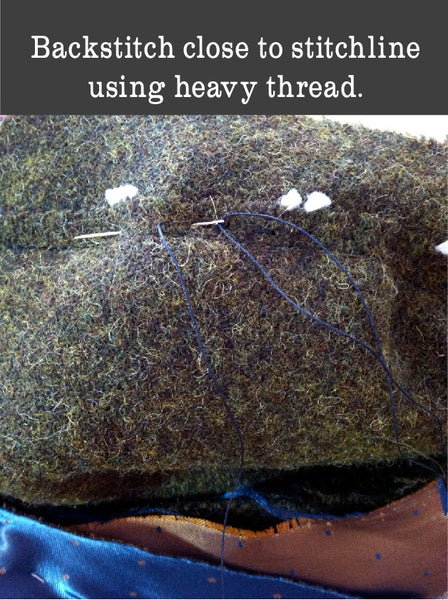
I was able to go through the shoulder pad and catch the lining on the other side, but if your shoulder pads are thick you might have to do a second line of backstitching from the lining side, catching the shoulder pad to the lining. Trim away the extra wool, canvas, lining, and shoulder pad; I usually leave only ¼ inch under the arm and taper to ½ inch at the top and sides of the armscye. Sew a sleeve head in the armscye, starting at the front notch or sleeve seam and going around the top of the sleeve to the back sleeve seam. Sleeve heads fill out the ease at the top of the sleeve and give a smooth look to the shoulder. You can buy them or make your own; I used a bias strip of wool 2 inches wide, folded over about ½ inch and pressed.

Fold the sleeve lining over ¼" and slip stitch in place, matching seams with the sleeve and just covering the backstitching. Its perfectly acceptable to have small gathers in the lining around the top of the sleeve. Lining rarely eases as nicely as wool.

Tailored Peacoat Series: #5

I split the under collar at the center back. I cut two pieces on the bias from hair canvas, trimming away the seam allowance, and also cut two bias under collar pieces from wool. If you are suave like Matt (Matt appreciates that statement, thanks Dana! :P) and want to pop the collar of your coat, I would cut the under collar from a single piece, but you can still cut the interfacing on the bias.
I lightly pad stitched the canvas to the under collar, making sure I didn't go all the way through the wool - but my wool is quite thick and fuzzy, so if your fabric is thinner or has a tighter weave and you’re worried your stitches might show, its okay to skip pad stitching.

Cross stitch the canvas to the wool to keep the edges in place.

Fold the seam allowance up from notch to notch along the neck edge and baste in place.
Lay the coat out with the neck facing you, and with the wool side of the under collar up, pin the collar to the neck edge matching center back and the notches. I also put a pin at the roll line.

Making sure the canvas and linings are laying nicely inside the coat, and easing as needed along the neck edge, baste the collar to the coat.

Check to make sure the lining isn't doing anything weird (sometimes it likes to jump around) --- (Remember that Dana didn't use the back neck facing so she is dealing with lining fabric at the neck seam) --- and sew the collar to the coat using a fell stitch and double thickness of thread (to see how to do the fell stitch, have a look at the second stitch on Colette Patterns' "Basic Hand Stitches" guide). Don’t be afraid to catch the facing and lining.

From the inside, cross stitch the neck seam allowance to the collar, clipping where needed to get it to lie flat.

Cut a piece of fabric about 1 ½ inches wider and 2 inches longer than the under collar. Fold it in half, and using a hot steam iron, stretch the top and bottom long edges.
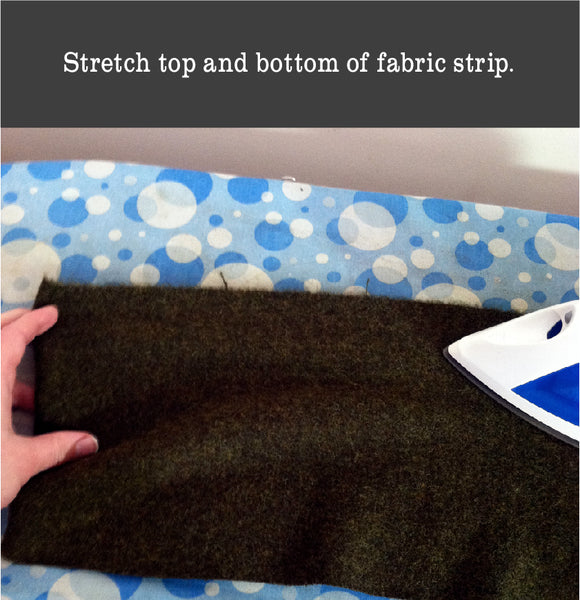
Don’t stretch the center of the strip. When you’re done, it should ripple on both edges.

Mark the center of the strip. Align the center of the strip with the center back of the collar and pin in place. Its easiest to do this with the coat on a dress form, but you can also drape it over your knee or hand/arm.

Working from the center back to the front, smooth the fabric over the collar, keeping the straight edge at the top even with the seam allowance of the under collar, and pinning as you go. You’re trying to build some ease into the upper collar so it will roll nicely.

Its okay to trim some of the excess fabric if its getting difficult to work with, just make sure you have plenty for seam allowances.
Once the upper collar is pinned in place, baste around the outer edge of the collar, and remove the pins.

Sew the outer edge of the collar from notch to notch with the canvas side facing up, similar to how the front facing is sewn onto the coat front. Press the seam open and grade and trim the seam allowance. Turn the collar right side out, and baste close to the edge, rolling the seam towards the under collar, like the front edge. Put a line or two of basting in the collar, working from the edge towards the coat, then fold the collar under (like the lapels on the facing) and run a line of basting to keep the ease in the upper collar.

Trim the neck edge of the upper collar so you have 3/8" to 1/2" seam allowance, and turn it under and baste in place. Slip stitch in place.

Well, there you go, the collar is finished! How different from our usual approach to sewing a collar! I look forward to draping my own upper collar when I sew Matt his tailored Goldstream in time for next winter.
Thank you to everyone who has commented via the blog/email/in person about the useful nature of this series. Dana put a lot of work into all of these posts and I am sure many of us will be referring to her teachings for all sorts of coat projects in the future!
Look forward to a post on an alternative approach to setting in sleeves tomorrow!
Tailored Peacoat Series: #4

Today is a bit of a shorter post during which Dana demonstrates how to securely place the shoulder pads and shows us her method for assembling the side and shoulder seams of the coat and lining. You may notice that the procedure is a little different than outlined in the Goldstream Peacoat instruction booklet because the lining pieces have already been separately basted to their corresponding self pieces. Dana's process involves a lot of hand stitching to complete the lining and I am sure you will agree that this is a very effective way to ensure complete accuracy when sewing such a slippery fabric.
Side Seams (both coat and lining) and Hem
Sew the side seams together and press open. To sew the lining, at the side seams, fold one edge over the other making sure there’s a bit of ease in the lining. Slip stitch the lining seams.
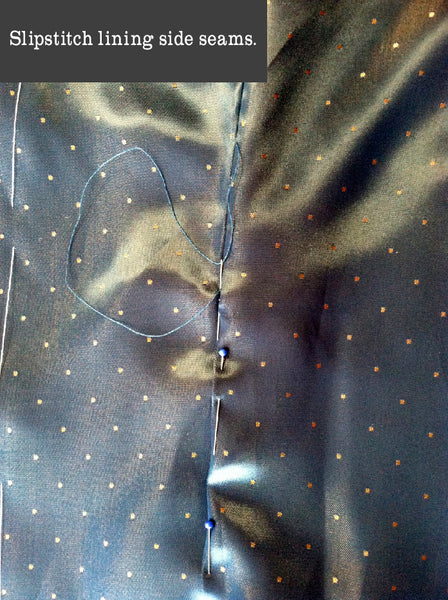
Baste the hem up close to the edge, then again about half an inch down from the cut edge.

Make an ease pleat in the lining, then slipstitch the lining down.

Shoulders Seams and Pads
Sew the shoulder seams. Since most back shoulders are bigger than the front shoulder, its easiest to sew with the front on top and the back will ease itself in while you stitch.
I've found it much easier to place shoulder pads when the coat is on a dress form, or at least on a person. My shoulder pads have a center notch; align this with the shoulder seam, and pin the pad in place.

Move the pins so they’re holding the pad to the canvas (separated from the coat fabric), and diagonally baste the pad from the canvas side.

Turn the canvas over, and cross stitch the pad to the canvas.
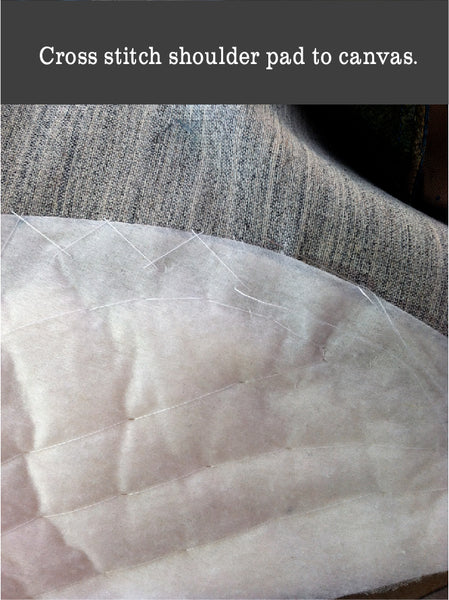
Re-align the canvas and shoulder pad in the coat (its easy to do this over your hand) and baste it in place.

Fold the back lining over the front lining and facing, and baste in place.

Tailored Peacoat Series: #3

Today, on the third day of our Tailored Peacoat Series, Dana will be teaching a few tricks to put into practice while sewing your Goldstream Peacoat facing and lining:
The Facing and Lining
I overcut coat linings, with the exception of the front edge that is attached to the facing. Fabrics, especially slippery lining fabrics, tend to shift and not always do what you want them to, so its very helpful having a bit of extra fabric to work with. I sewed the front facing to the front lining, stopping about an inch from the hem, trimming the seam allowances to 1/4” and inserting a strip of bias cut from the wrong side of my lining fabric. The bias strip is purely decorative, but can be a nice little bit of color. Instead of doing an interior patch pocket, I made double piped pockets.

Sew the coat front and the facing/lining together, from the collar notch where you stopped trimming the canvas to the end of the facing at the hem. Its easiest to sew with the coat side facing up, and stitching about a needle’s distance from the canvas. Grade the seam allowance and press the seam open. Baste the front edge, rolling the facing to the inside below the top button mark. When you get to the lapel, baste so the seam is in the center.

Once the edges are basted, run a line of basting in the center of the lapel, then baste the roll line, stopping about an inch below the neck edge.
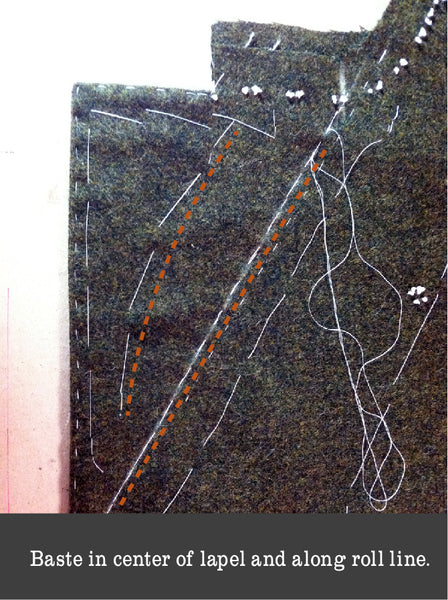
Fold the lapel over, and working from the inside of the coat, baste a couple lines, working from the edge of the coat towards the lining. Folding the lapel will ensure it has enough room to roll easily when worn.
Baste close to the facing/lining seam, then fold the lining back and cross stitch the facing to the canvas, working around the pocket.

Fold the lining back far enough so the pocket can lay flat, then cross stitch the side of the pocket to the canvas.

Lay the lining flat, and baste it down, leaving plenty of room for the armscye, side seams, and hem.

From the front of the coat, trim the lining even with the wool around the shoulders, armscye, and side seams.

At the neck edge, clip the facing to the neckline about 1” past the roll line.

Then, fold the fabric under and even with the neck edge. Baste, then slip stitch, down.

The fronts are done!
The Back and Lining
I cut the back lining from the same piece as the back, since I’m not using the back facing. I did leave enough in the lining for an ease pleat center back. Once the center back seam and center back of the lining are sewn, baste them together along the center back seam, then in a horseshoe shape, leaving room for side seams, shoulder pads, and hems.

Now that all the lining and facing pieces are assembled and basted to the main coat, we are ready to sew the main coat seams and insert the shoulder pads tomorrow!
Tailored Peacoat Series: #2

Today, the second day of our Tailored Peacoat Series, Dana is walking us through a couple minor changes to the front patch pockets. She will also be discussing the use of hair canvas to interface the coat front. Okay, lets get right into it:
The Front Patch Pockets
The only change I made to the pockets was to fuse a piece of interfacing to the top of the pocket (the part that will be folded over to the back). It will keep the pocket from stretching (this is a great tip, especially if the wearer likes to shove their hands into their pockets quite often). I used weft interfacing.

I basted around the edge of the pocket, making sure the lining rolled to the inside. I also did this for the pocket flap.

Using the placement markings for the top of the pocket as a guide, I basted a piece of pocketing (I used washed quilting cotton, but there are pocketing fabrics and Silesia out there) on the wrong side to act as a stay for the pocket (Definition: A stay is a piece of material applied to the wrong side of the self fabric to provide extra strength and resilience. An example that is commonly visible in ready to wear clothing is a button sewn to the inside of a garment at the same time as the exterior button is sewn. When used, the button will be pulling on the inside button rather than stretching out and damaging the self fabric). The stay fabric should be about 2” wider than the finished pocket and 3” tall. Position it so it will be behind the flap but still low enough to catch the top of the pocket.

I basted the pocket in place before slip stitching the edge down, then top-stitching. Yes, I do LOTS of basting.
Applying Canvas/Interfacing
In a hand tailored coat, the interfacing is attached to the coat front, not the facing. I used hair canvas for interfacing. You can buy premade coat fronts, or make your own. If you buy one, I’d recommend getting a few sizes bigger than the coat you’re making, so you know it will be big enough. (You can find this one in the Goldstream Tailoring Supplies Kit or you can buy them individually at B. Black and Sons.)

Lay the coat front on top of the canvas, and baste in the center of the canvas, making sure you leave space at the top for the shoulder pads, and don’t extend beyond the hem line.

Baste along the front edge, about an inch from the roll line and across the bottom, and at the far edge of the canvas and about 2” away from the armscye so you have room to set the sleeves.

Next, baste the roll line, taking smaller stitches so its easier to see the line from the back of the coat, and baste the lapel. If the canvas extends beyond the fabric in any places, trim it so they’re even.

To pad stitch or not to pad stitch; that is the question (Gertie has written a tutorial on pad stitching as part of her Lady Grey Sew-Along). On a suit coat, you would pad stitch the lapel, shaping the wool and canvas so the lapel rolls and sits nicely on the finished suit. Overcoats, however, are often designed with the lapels to be worn open or closed, and if both sides of the lapel will be visible, you don’t want the stitches from pad stitching to be seen. If you know the lapels will always be worn open and want to pad stitch the lapels, go for it.
Trim the canvas even with the edge of the front and hem (here’s where knowing exactly where the edge is comes in handy), stopping at the notch for the collar. Cross stitch (also called catch stitch) the canvas to the coat.

Why didn't I tape the front edge? Taping the front edge keeps it from stretching, important if you have any curved edges, and makes a nice crisp edge. However, coupled with heavy fabric, it creates extra bulk, and the top-stitching will reinforce the front edge.
In the last picture, you can see that I divided the roll line into thirds in preparation for taping the roll line. I used 3/8” cotton twill tape. Please use cotton tape, not that poly stuff sold in packages. It doesn't respond well to a hot iron and lots of steam. Pin the end of the tape 1/3 of the way from the front edge, mark the 2/3 spot, then pull the tape 1/4" to 3/8” past the mark, then lay the tape flat along the rest of the roll line. There should be some rippling in the coat.

Baste the tape down, easing in the excess.

Whip stitch the tape down, catching only the canvas, then press the crap out of it (Nicely said Dana :P). The ease will press out, and the tape will keep the roll line snug against the wearer.

And that's it for today's lesson! Tomorrow we will move on to sewing the facing and the lining. I meant to remind everyone last post, but forgot so will remind you here instead: We have an Encyclopedia Peacoatica that was compiled by us from your wonderful contributions a couple months ago. It's a great place to go to find links to resources when planning to start your Goldstream Peacoat!
Tailored Peacoat Series: #1

This week I have a surprise treat for you! A mini sewing series for all you aspiring tailors out there!
This post will be the first of a week long daily series about the Goldstream Peacoat. The Goldstream Peacoat was designed to be the easiest and simplest peacoat possible to sew. The instructions produce a nicely finished coat that is equivalent to those you would find in affordable and good quality ready-to-wear stores. I think that sewers will and do appreciate the simplicity of the pattern. That being said, there is absolutely nothing stopping you from using the Goldstream Peacoat to create a high-end tailored garment that will last the wearer a life time! Indeed, after these seven posts you will be familiar with all the tricks and practices necessary to elevate your peacoat sewing project to a "Tailored" status.
Here is the posting schedule:
I am by no means a skilled and practised tailor. Fortunately, Dana, one of our very skilled pattern testers, is! She has put a huge amount of work into documenting her Goldstream Peacoat sewing process and, you can see by the beautifully crisp results, that all her efforts paid off. I hope that you will be able to benefit from her kind offer to share her knowledge. She has done an excellent job of thoroughly explaining each step she took. Thank you so much for doing this Dana and welcome to the Thread Theory blog!

- Dana's beautifully tailored peacoat modelled by Travis.
Now, without further ado, here is Dana with her week long tailoring series:
I’m Dana, and I’ve been doing theatrical costuming for 11 years. I’ve always loved futzy handwork, and tailoring is a great way to indulge in it. The theater I work for has some amazing tailors, and I’ve learned so much about menswear and construction from them. While the patterns we work with are custom drafted, there are lots of tailoring techniques that translate to commercial patterns.
Basic tips to begin creating a tailored Goldstream Peacoat:
Two things you do much more of in tailoring are basting and pressing.
- I baste in white thread or a color that matches my fabric.
- Pressing with lots of steam will help you shape a coat beyond what seams and interfacing could ever do. Since you will use so much heat and steam, it’s important to pre-shrink, or at least steam press, your fabric, lining, and all interfacings and tapes you will use.
Helpful Tailoring Resources and Materials:
I found the wool, lining, and hair canvas at a local fabric store. The buttons are from Mood, and shoulder pads and silk buttonhole twist are from B. Black and Sons. B Black is a fantastic place to get everything you need to make a coat, and their customer service is great.
You’ll also want beeswax so you can wax and press thread for hand-sewing. (If you would like to know more about using beeswax, have a look at this BurdaStyle article.)
The two books I use the most are Classic Tailoring Techniques by Roberto Cabrera and Patricia Flaherty Meyers, and Tailoring Suits the Professional Way by Clarence Poulin. The Poulin book is out of print, but if you can get your hands on a copy it really is a fantastic book.
Pattern Prep and Cutting
-
Optional - Adjusting the Seam Allowances: The first thing I did was remark the pattern pieces to have ¼” seam allowance, except at the front edge, neckline, and hems. I cut all the seam allowance off of those. Using ¼” seam allowance is a personal preference, although it really comes in handy when setting sleeves.
It is very helpful to know where the stitch lines for the front edge, neck, and hems are, though. - Necessary - Finding the Roll Line: You do need to figure out where the roll line is on the coat front (Definition: The roll line is where the collar/lapel folds over on a garment) . The roll line starts at the top button, and is angled towards the neck, coming about 1/2” away from the neck seam line at the shoulder.
The top of the roll line is about 3 ½” from the notch for the end of the collar on a size large.
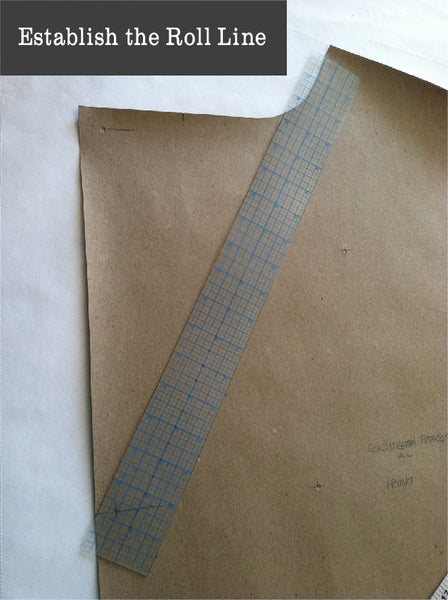
After I marked my new pattern lines on the fabric, along with all the notches, button placements, etc, I did add seam allowances beyond ¼”, along with 1” on the front and neck, and at least 1½” on the coat and sleeve hems.
Tailor Tacks (i.e. mark where you will be sewing)

I tailor tacked all the pattern lines (Note: Details on how to make tailor tacks are included in the peacoat instruction booklet); even if you don’t want to make the seam allowance changes I made, I would recommend tailor tacking the front edge, neck edge, hems, and all the notches, button marks, pocket marks, etc. It’s one of the easiest ways to make sure you can see these marks on both sides of the fabric, and if you’re working with thick wool like I am, chalk marks tend to fade pretty quickly. I used crochet cotton for tailor tacking thread because it grabs fabric better than regular thread.

Thanks for this first post, Dana!
That is quite a lot of handwork to keep you busy. Tomorrow we will move on to demonstrating how to adjust the pockets to suit the tailored coat and how to apply horse hair canvas and interfacing.
Are you already learning lots? I know I am!
Day 3: Jedediah Sew-Along | Guest Post - How to sew back pockets with no interior raw edges
Today we have another guest post treat - this time from Katie, the author of the blog, The Creative Counselor. She is the test sewer who made this version of the Jedediah Pants. She used a gorgeous recycled hemp and organic cotton blend and widened the legs to create a totally different style of pants than our slim fit originals - I love how well these pants display the versatility of a well fitting pants pattern - all you have to do is adjust the width or length of the legs to create endless varieties and styles!
Day 1: Jedediah Sew-Along | Guest Post - How to Save Fabric when cutting out your Jedediah Pants
Meg, of Made By Meg was one of the test sewers for our Jedediah Pants pattern. She was the sewer who produced this spectacular pair of denim pants (with musical themed pocket linings!):












